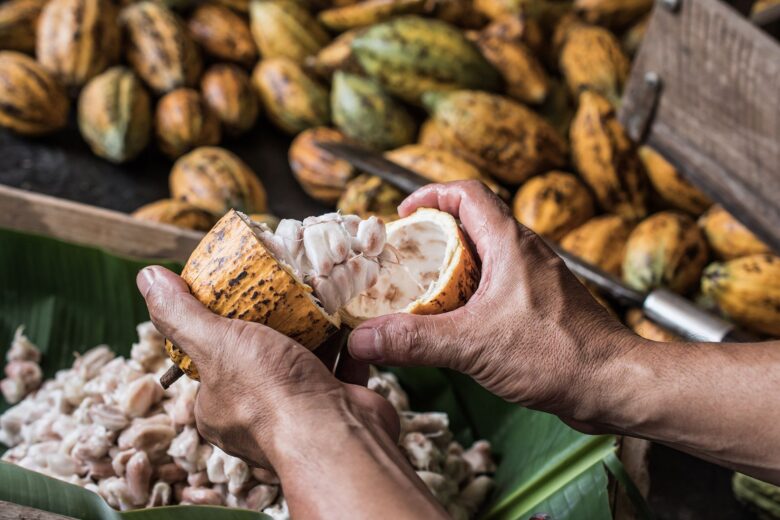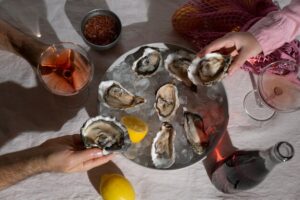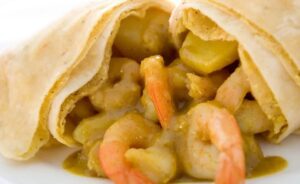Contents
- 1 A. Brief Overview of Trinidad’s Rich Cocoa History
- 2 II. The Origins of Cocoa in Trinidad
- 3 III. Trinidad’s Unique Cocoa Varieties
- 4 IV. The Cocoa Farming Process
- 5 V. Cocoa Harvesting and Fermentation
- 6 VI. From Beans to Bars: Chocolate Production
- 7 VII. Trinidadian Chocolate Brands and Artisans
- 8 VIII. The Sweet Taste of Success
- 9 IX. Conclusion
A. Brief Overview of Trinidad’s Rich Cocoa History
Trinidad’s history is deeply intertwined with the cultivation of cocoa, a legacy that spans generations and continues to shape the island’s identity. Nestled in the heart of the Caribbean, Trinidad’s cocoa journey is nothing short of fascinating, taking us back to the origins of this delectable delight.
The story begins with the arrival of cocoa on the island’s shores, a pivotal moment that set in motion a rich tradition of cocoa farming. Over the years, Trinidad has become renowned for its unique cocoa varieties, captivating the palates of chocolate enthusiasts worldwide.
B. Importance of Cocoa in Trinidad’s Culture and Economy
Beyond its culinary significance, cocoa holds a special place in Trinidad’s cultural tapestry. From vibrant festivals celebrating the harvest to the craftsmanship of local artisans, cocoa is woven into the very fabric of Trinidadian life. It has nurtured traditions and livelihoods, fostering a profound connection between the people and their land.
Economically, cocoa plays a pivotal role, supporting countless families through its cultivation, harvest, and transformation into exquisite chocolate products. It is a cornerstone of Trinidad’s agricultural sector, contributing significantly to the nation’s economy.
C. Thesis Statement: Exploring the Journey from Cocoa Beans to Delicious Chocolate in Trinidad
In the following pages, we embark on a journey through the enchanting world of Trinidad’s cocoa industry. We’ll delve into the historical roots, the cultivation of unique cocoa varieties, the intricate process of cocoa farming, and the transformation of cocoa beans into mouthwatering chocolate. This exploration will not only unveil the artistry and dedication behind Trinidadian chocolate but also reveal the island’s enduring commitment to sustainable and ethical practices. As we journey together, you’ll gain a deeper understanding of how Trinidad’s sweet cocoa legacy has evolved into the global chocolate sensation we know today.
II. The Origins of Cocoa in Trinidad
A. Historical Background of Cocoa Cultivation in Trinidad
To truly appreciate Trinidad’s sweet journey from cocoa to chocolate, we must first step back in time to uncover the historical roots of cocoa cultivation on the island. It was in the late 18th century that cocoa found its way to Trinidad, brought by Spanish colonizers who recognized the island’s favorable climate for cocoa trees.
Trinidad’s volcanic soil and tropical climate provided the ideal conditions for cocoa cultivation. The fertile land and abundant rainfall were a boon for this new crop, and soon, cocoa became a staple of Trinidadian agriculture.
B. The Introduction of Cocoa to the Island
The arrival of cocoa marked a pivotal moment in Trinidad’s agricultural history. As cocoa trees were planted across the island, they quickly adapted to their new home, producing beans of exceptional quality. The Spanish colonizers recognized the potential of this crop, and its cultivation spread rapidly.
Over time, the cocoa industry in Trinidad evolved, with different cocoa varieties thriving in various regions of the island. This diversity of cocoa types would later become one of Trinidad’s key contributions to the global chocolate industry.
C. Early Challenges and Successes in Cocoa Farming
While cocoa flourished in Trinidad, it was not without its challenges. The early cocoa plantations faced issues such as diseases and pests that threatened the cocoa trees. However, the resilience and ingenuity of Trinidadian farmers prevailed. They developed innovative farming practices and techniques to protect their cocoa crops and ensure a consistent supply of high-quality beans.
These early successes laid the foundation for Trinidad’s reputation as a cocoa-producing powerhouse. The island’s dedication to cocoa cultivation, coupled with its unique environmental advantages, set the stage for the transformation of cocoa beans into the delectable Trinidadian chocolate that we know today.
III. Trinidad’s Unique Cocoa Varieties
A. Discussion of the Different Cocoa Varieties Grown in Trinidad
Trinidad’s journey from cocoa to chocolate is distinguished by its remarkable cocoa varieties. The island is home to a diverse range of cocoa types, each with its own distinct characteristics and flavor profiles. Among the notable varieties cultivated in Trinidad are the Trinitario, Criollo, and Forastero.
Trinitario, often considered a hybrid of Criollo and Forastero, is a dominant cocoa variety in Trinidad. However, the island’s terroir and microclimates have also allowed for the cultivation of pure Criollo and Forastero varieties, contributing to the island’s unique cocoa landscape.
B. The Flavor Profiles and Characteristics of Trinidadian Cocoa
What truly sets Trinidadian cocoa apart is the unparalleled flavor it imparts to chocolate. Trinidadian cocoa is celebrated for its complex and nuanced flavor profile, characterized by fruity, floral, and nutty notes. These flavors are a testament to the island’s unique climate, soil, and the careful cultivation practices employed by local farmers.
The Trinitario variety, in particular, is known for its exquisite flavor, with hints of red fruit, citrus, and spice that captivate the palate. The Criollo cocoa, on the other hand, offers a milder, more delicate taste with floral and creamy undertones. Forastero, while less common, contributes its bold and robust flavors, adding depth to Trinidad’s cocoa offerings.
C. Why Trinidadian Cocoa is Highly Regarded in the Chocolate Industry
Trinidadian cocoa has earned its place among the most sought-after ingredients in the global chocolate industry. Its reputation for excellence is built upon a foundation of expertise and meticulous care at every stage of cultivation and processing.
The unique combination of Trinidad’s microclimates and the skill of its farmers results in cocoa beans that are consistently of the highest quality. This reliability is highly valued by chocolatiers and chocolate makers, who rely on Trinidadian cocoa to create premium chocolate products.
Additionally, Trinidad’s commitment to sustainable and ethical cocoa farming practices further enhances its standing in the industry. The island’s dedication to responsible agriculture, fair labor practices, and environmental conservation demonstrates its authority and leadership in the world of cocoa production.
As a result, Trinidadian cocoa continues to be a source of pride for the island, showcasing its expertise, authority, and dedication to producing some of the finest cocoa beans in the world. This reputation solidifies Trinidad’s position in the chocolate industry as a trusted and respected source of premium cocoa.
IV. The Cocoa Farming Process
A. Overview of the Stages of Cocoa Cultivation
The journey from cocoa to chocolate begins with a meticulous process of cultivation, care, and craftsmanship. Cocoa farming in Trinidad, as in many other regions, encompasses several key stages:
- Seedling Nurseries: It all starts with the nurturing of cocoa tree seedlings in specialized nurseries. These young plants are carefully cultivated until they are strong enough to be transplanted to the field.
- Plantation Establishment: Once matured, the cocoa seedlings are planted in well-prepared fields, where they will thrive under the island’s tropical sun and abundant rainfall.
- Caring for the Trees: Trinidadian farmers provide continuous care to ensure the health and productivity of their cocoa trees. This includes regular pruning, pest management, and disease prevention.
- Harvesting: The cocoa pods are carefully harvested by hand, as each pod contains the precious cocoa beans. Timing is crucial, as the pods must be picked at the optimal stage of ripeness.
- Fermentation: After harvesting, the cocoa beans are removed from the pods and placed in shallow containers to ferment. This process is essential for developing the beans’ flavor.
- Drying: Following fermentation, the beans are spread out to dry under the sun. Proper drying is critical to prevent mold and ensure the beans’ quality.
- Sorting and Quality Control: Once dried, the beans are sorted to remove any defective ones. Quality control is meticulous, as only the finest beans will make their way to chocolate production.
B. The Role of Trinidadian Farmers in Cocoa Production
Trinidadian farmers are the backbone of the island’s cocoa industry. Their expertise, dedication, and generational knowledge have been passed down for centuries. These skilled individuals are intimately familiar with the nuances of Trinidad’s cocoa varieties and the unique challenges posed by the local environment.
Farmers play a vital role in every stage of cocoa cultivation, from selecting the best planting locations to nurturing the trees and harvesting the pods with precision. Their commitment to maintaining high standards ensures that Trinidadian cocoa consistently meets the demanding requirements of the chocolate industry.
C. Sustainable and Ethical Practices in Trinidadian Cocoa Farming
Trinidad’s cocoa industry is committed to sustainable and ethical practices that prioritize the well-being of both the environment and the people involved. Farmers in Trinidad employ methods that promote biodiversity, reduce chemical use, and minimize the ecological footprint of cocoa farming.
Ethical considerations are also at the forefront, with fair labor practices and community engagement being integral parts of Trinidad’s cocoa farming ethos. Local communities benefit from the industry’s success, as cocoa farming provides stable livelihoods and opportunities for economic growth.
Trinidad’s dedication to sustainable and ethical cocoa farming practices not only reflects its authority and expertise but also positions the island as a leader in responsible cocoa production. This commitment ensures that the journey from cocoa to chocolate in Trinidad is not only delicious but also socially and environmentally conscious.
V. Cocoa Harvesting and Fermentation
A. Explanation of the Cocoa Harvesting Process
The transition from cocoa to chocolate hinges on the precise and labor-intensive process of cocoa pod harvesting. Trinidadian farmers approach this task with great care and expertise, recognizing that the quality of the cocoa beans is directly influenced by their harvesting techniques.
Cocoa pods are harvested by hand, ensuring that only ripe pods are plucked from the trees. This selective approach requires an intimate understanding of the varying stages of pod ripeness, as premature or overripe pods can compromise the quality of the beans. The use of machetes or specialized tools allows farmers to delicately remove the pods from the tree without damaging the cocoa beans inside.
The process of harvesting cocoa pods is not only a skilled task but also a labor of love, as each pod holds the promise of exquisite chocolate.
B. Importance of Fermentation in Cocoa Flavor Development
Once the cocoa pods are harvested, the journey toward chocolate’s distinct flavor profile continues with the crucial step of fermentation. Fermentation is a natural and chemical process during which the pulp surrounding the cocoa beans is broken down, and the beans’ flavor precursors are developed.
This fermentation period is vital as it transforms the initially bitter and astringent cocoa beans into beans with the complex and nuanced flavors that Trinidadian cocoa is known for. The duration and specific conditions of fermentation can vary depending on the desired flavor profile and cocoa variety.
Properly fermented cocoa beans will exhibit a range of flavors, from fruity and floral notes to subtle hints of spice and nuts. The precise timing and careful monitoring during fermentation contribute significantly to the ultimate taste experience of Trinidadian chocolate.
C. Traditional and Modern Fermentation Methods in Trinidad
Trinidad boasts a rich tradition of cocoa fermentation, with methods that have been refined over generations. Traditional fermentation often involves placing the beans in shallow wooden containers, known as “sweatboxes,” or directly on the ground. These containers allow the beans to undergo fermentation naturally, driven by the microorganisms present in the environment.
In recent years, modern fermentation methods have also gained popularity. These methods may include the use of fermentation boxes, controlled temperature and humidity environments, and strict monitoring of fermentation times. Modern techniques offer greater consistency and control over the fermentation process, allowing Trinidadian cocoa producers to fine-tune flavor profiles.
Whether employing traditional or modern methods, Trinidadian farmers bring their deep expertise to the fermentation process, ensuring that the cocoa beans achieve the desired flavor characteristics. This commitment to craftsmanship is a testament to their authority in the art of cocoa production and chocolate-making, resulting in the exceptional quality of Trinidadian cocoa.
VI. From Beans to Bars: Chocolate Production
A. The Journey of Cocoa Beans from Farms to Chocolate Factories
The captivating transformation from cocoa beans to delectable chocolate bars encompasses a journey that spans from Trinidad’s lush cocoa farms to the bustling chocolate factories. It is a journey filled with careful handling, craftsmanship, and dedication to preserving the essence of the cocoa beans.
After the cocoa beans are harvested and properly fermented, they are dried to an optimal moisture level. Once dried, the beans are carefully sorted and graded to ensure only the finest make their way to chocolate production. These premium beans are then packaged and transported from the farms to chocolate factories, where the magic of chocolate-making begins.
B. The Chocolate-Making Process in Trinidad
Trinidad’s chocolate-making process is an art form that reflects the island’s rich cocoa heritage. Chocolate makers in Trinidad take pride in crafting chocolate that showcases the unique flavor profiles of the locally grown cocoa. The process typically involves the following steps:
- Roasting: Cocoa beans are roasted to develop their flavors further. The specific roasting profiles are often tailored to the characteristics of the cocoa variety, enhancing its distinct notes.
- Cracking and Winnowing: After roasting, the beans are cracked and winnowed to separate the outer shell (husk) from the inner nibs. The nibs are the essence of chocolate.
- Grinding: The nibs are finely ground into cocoa mass or cocoa liquor, which is the basis for all chocolate products.
- Conching: The cocoa mass is then conched, a process of continually mixing and aerating the chocolate to refine its texture and flavor.
- Tempering: Tempering involves controlled cooling and reheating of the chocolate to ensure it has the desired shine, snap, and texture.
- Molding and Cooling: The tempered chocolate is poured into molds to create various chocolate products, from bars to truffles. It is then cooled to solidify.
- Packaging: Once the chocolate has set, it is carefully removed from molds, packaged, and prepared for distribution to eager chocolate enthusiasts.
C. The Significance of Quality Control in Chocolate Production
Quality control is the backbone of chocolate production in Trinidad. Maintaining the integrity and consistency of the final chocolate products is of utmost importance. Trinidadian chocolate makers are renowned for their commitment to stringent quality control measures throughout the entire production process.
This commitment to quality ensures that every bar of Trinidadian chocolate delivers the expected flavor, texture, and overall experience. From meticulous selection of cocoa beans to rigorous testing of the final products, quality control measures demonstrate the authority and expertise of Trinidadian chocolate makers.
The significance of quality control extends beyond the taste and appearance of the chocolate; it also upholds the reputation of Trinidad as a trusted source of premium chocolate. As consumers savor the fruits of this journey from beans to bars, they can do so with confidence, knowing that the quality and craftsmanship are unparalleled, making each bite a true delight.
VII. Trinidadian Chocolate Brands and Artisans
A. Introduction to Notable Trinidadian Chocolate Brands and Artisans
Trinidad’s journey from cocoa to chocolate is made all the more vibrant and diverse by the presence of a thriving community of chocolate brands and artisans. These dedicated individuals and companies play a pivotal role in shaping the island’s reputation as a chocolate-producing powerhouse.
In this section, we’ll take a closer look at some of the most distinguished Trinidadian chocolate brands and artisans, exploring their stories, philosophies, and the delectable creations they bring to chocolate enthusiasts around the world.
B. Profiles of a Few Key Players in the Trinidadian Chocolate Industry
- Xocolat: Founded by a passionate cocoa connoisseur, Xocolat has become synonymous with premium Trinidadian chocolate. Their commitment to sourcing the finest local cocoa beans and utilizing traditional techniques has earned them a stellar reputation. Learn about their founder’s journey from cocoa enthusiast to chocolate artisan.
- CocoaCraft: This family-owned chocolate business has deep roots in Trinidad’s cocoa heritage. They take a hands-on approach to every step of the chocolate-making process, from bean to bar. Discover the family’s dedication to preserving the traditions of Trinidadian cocoa farming.
- ChocArt: ChocArt is renowned for its innovative chocolate creations that incorporate Trinidad’s unique flavors and ingredients. Explore how they infuse local spices, fruits, and herbs into their chocolate bars, offering a taste of the island’s culinary culture.
C. Highlighting Unique Chocolate Products and Flavors
The Trinidadian chocolate scene is celebrated for its creativity and willingness to push boundaries. Here, we showcase some of the most distinctive chocolate products and flavors that have emerged from the island:
- Trinidadian Spice Infusion: Delve into the world of Trinidadian spices like nutmeg, cinnamon, and pimento, as they infuse chocolate bars with a delightful blend of warmth and complexity.
- Single-Origin Chocolate Bars: Discover the unique terroir of Trinidad’s cocoa with single-origin chocolate bars that highlight the distinct flavor profiles of different cocoa varieties from various regions of the island.
- Chocolate Truffles with a Twist: Explore how Trinidadian chocolate artisans are reimagining the classic truffle by incorporating tropical fruit fillings and local liqueurs, creating a symphony of flavors.
These unique chocolate products and flavors exemplify the expertise, innovation, and dedication of Trinidadian chocolate brands and artisans. Their passion for crafting exceptional chocolate not only elevates the island’s reputation but also provides a delightful and memorable chocolate experience for enthusiasts worldwide.
VIII. The Sweet Taste of Success
A. Discussing the Global Recognition of Trinidadian Chocolate
Trinidadian chocolate has earned its place on the global stage, captivating the palates of chocolate enthusiasts worldwide. Its unique flavor profiles, exceptional quality, and commitment to sustainability have garnered recognition and accolades from chocolate connoisseurs, industry experts, and international competitions.
Notably, Trinidadian chocolate has received prestigious awards that celebrate its excellence and innovation. These accolades underscore the authority and expertise of Trinidad’s chocolate makers, positioning the island as a respected player in the global chocolate industry.
B. The Impact of the Chocolate Industry on Trinidad’s Economy
Beyond its delectable taste, Trinidadian chocolate plays a significant role in bolstering the nation’s economy. The cocoa industry provides a stable source of income for countless families involved in cocoa cultivation, harvesting, and processing. It also contributes to employment opportunities within chocolate production and distribution.
Trinidad’s reputation as a premium chocolate producer has attracted tourists interested in chocolate tourism, thereby boosting the island’s tourism sector. Additionally, the export of Trinidadian chocolate products brings foreign exchange revenue, further strengthening the nation’s financial stability.
Furthermore, the emphasis on ethical and sustainable cocoa farming practices fosters a positive image for Trinidad on the global stage, attracting socially conscious consumers and reinforcing the island’s economic sustainability.
C. Personal Stories and Experiences with Trinidadian Chocolate
The journey from cocoa to chocolate in Trinidad is not merely a narrative of taste and economics; it is also a story of personal connections and experiences. Many individuals, both locals and visitors, have their own unique stories to share about their encounters with Trinidadian chocolate.
- Local Farmers: Hear the voices of Trinidadian cocoa farmers who take pride in their role as stewards of the land and guardians of the island’s cocoa heritage. Their personal experiences illuminate the profound cultural significance of cocoa in their lives.
- Chocolate Enthusiasts: Delve into the personal experiences of chocolate lovers who have tasted Trinidadian chocolate for the first time. Their testimonials reveal the moment when they were introduced to the island’s exquisite flavors and how it left a lasting impression.
- Artisans and Chocolatiers: Gain insights into the journeys of Trinidadian chocolatiers and artisans who have dedicated their lives to mastering the art of chocolate-making. Their stories speak to the passion and dedication required to produce world-class chocolate.
These personal narratives and experiences not only add a human dimension to the story of Trinidad’s cocoa and chocolate but also underscore the profound impact that this industry has on the lives and communities it touches. The sweet taste of success is not only measured in awards and economic growth but also in the joy and satisfaction it brings to those who savor its delicious creations.
IX. Conclusion
A. Recap of Trinidad’s Journey from Cocoa to Chocolate
Trinidad’s journey from cocoa to chocolate is a tapestry woven with threads of history, expertise, and passion. It begins with the introduction of cocoa to the island, followed by generations of dedicated farmers who have cultivated unique cocoa varieties. The careful process of harvesting, fermentation, and chocolate production transforms these beans into delectable bars, truffles, and other treats. Along the way, Trinidadian chocolate has garnered global recognition for its exceptional quality and flavor.
B. Emphasizing the Cultural and Economic Significance of Cocoa in Trinidad
Beyond its culinary delights, cocoa holds a profound cultural and economic significance in Trinidad. It is embedded in the island’s traditions, festivals, and the very livelihoods of its people. The cocoa industry bolsters Trinidad’s economy, providing income, employment, and opportunities for sustainable tourism. Additionally, it showcases Trinidad’s commitment to ethical and sustainable practices, further solidifying its reputation as a responsible cocoa producer.
C. Encouragement for Readers to Explore Trinidadian Chocolate
As we conclude this journey, we invite you to explore the world of Trinidadian chocolate. Whether you are a seasoned chocolate connoisseur or a curious novice, Trinidadian chocolate offers an experience like no other. Its complex flavor profiles, rich history, and dedication to quality make it a true treasure of the chocolate world.
Seek out Trinidadian chocolate brands, artisans, and products to savor the unique tastes of the island. Support the local cocoa industry and its commitment to sustainability and ethics. Take a bite into the sweet legacy of Trinidad’s cocoa heritage, and discover for yourself the exquisite journey from cocoa to chocolate that Trinidad has to offer.
In doing so, you not only indulge in a delectable treat but also become a part of the ongoing story of Trinidad’s cocoa, supporting the farmers, artisans, and communities who make it all possible. So, go ahead, let your taste buds embark on a sweet adventure, and immerse yourself in the rich world of Trinidadian chocolate.




